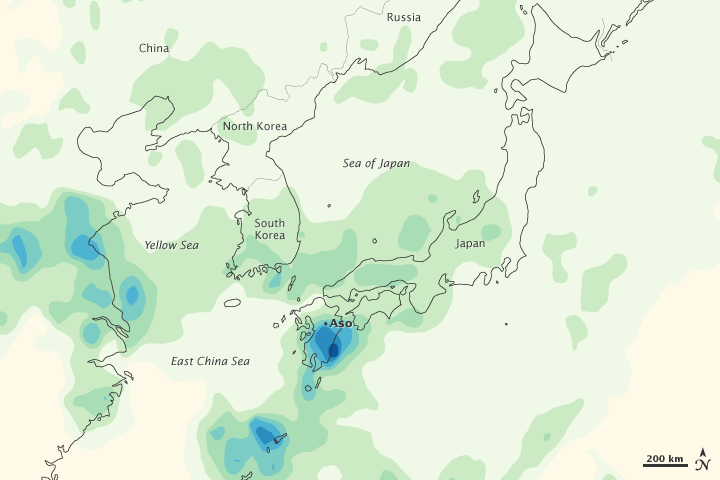


In early July, torrential rainfall caused floods on Japan’s island of Kyushu. News reports described rainfall totals in some areas as unprecedented, with as much as 20 inches (500 millimeters) falling on the town of Aso. Flood waters submerged fields and swept away cars, and mudslides destroyed homes.
This color-coded image shows rainfall totals from July 6 to 12, 2012. The heaviest rainfall—more than 300 millimeters or over 12 inches—appears in dark blue. The lightest rainfall—less than 50 millimeters or 2 inches—appears in light green. Trace amounts of rain appear in yellow. A pocket of intense rain appears immediately south of the town of Aso on the island of Kyushu, with the heaviest rain occurring along the coast.
This image is based on data from the Multisatellite Precipitation Analysis produced at NASA’s Goddard Space Flight Center, which estimates rainfall by combining measurements from many satellites and calibrating them using rainfall measurements from the Tropical Rainfall Measuring Mission (TRMM) satellite.
Because this image is an estimate of the rainfall recorded over a very large area when the satellites are overhead, it may miss pockets of heavy rain in smaller areas, or short periods of more or less intense rain. As a result, local rainfall totals measured from the ground may differ from the estimate shown here.
On July 13, 2012, MSNBC reported that the death toll had climbed to 19 as rescuers continued looking for people missing amid the rain. Meanwhile, The Japan Times reported that around 33,000 residents were under evacuation orders.
NASA Earth Observatory image by Jesse Allen, using data from the TRMM Science Data and Information System at Goddard Space Flight Center. Caption by Michon Scott.